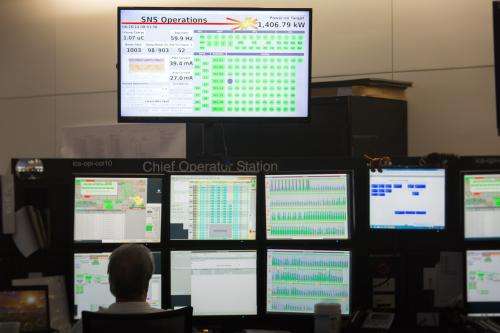The accelerator-based pulse neutron source at ORNL’s Spallation Neutron Source operated steadily for users at the maximum design power of 1.4 megawatts June 26. Credit: Genevieve Martin/ORNL.
The Spallation Neutron Source at the Department of Energy's Oak Ridge National Laboratory broke records for sustained beam power level as well as for integrated energy and target lifetime in the month of June.
For the first time, the accelerator-based pulsed neutron source operated steadily for users at its baseline design power of 1.4 megawatts on June 26.
"Over the past year, we have implemented technical and operational improvements to provide stable operation at 1.4 MW with little operating margin," said Kevin Jones, director of ORNL's Research Accelerators Division. "This achievement is the result of a lot of hard work by the dedicated and talented staff of our division."
SNS is a DOE Office of Science user facility that provides the most intense pulsed neutron beams in the world for scientific research and industrial development. SNS produces neutrons with an accelerator-based system that delivers short (microsecond) proton pulses to a target/moderator system, where neutrons are produced by a process called spallation.
"Running the accelerator at this power level is challenging," Jones said. "We have a great deal of work remaining over the next few years to add operating margin and to assure ongoing highly reliable operations. We have the best team available to get the job done."
Improving power production at SNS is valuable to a broad science community, which uses neutrons to study materials from superconductors to macromolecular biological systems.
"For my users and research teams, operating at 1.4 MW makes a big difference," said Paul Langan, head of the Biological and Soft Matter Division and director of the Center for Structural and Molecular Biology at ORNL. "The higher power provides more neutron flux that allows us to extend our reach and broaden our impact in the fields of soft matter and biological research by enabling measurements with smaller samples that are impossible at a lower power. For example we can look at thinner polymer films and smaller crystals of large medically important complexes."
Additionally, the SNS staff achieved three other power-related records recently. On June 8, they achieved a new 24-hour energy production record of 30.967 MW-Hrs, and on June 11, they achieved a new 12-hour record of 16.15 MW-Hrs during the night shift. For the week of May 19 to 25, 2014, the team set a new 7-day energy record of 189.8 MW-Hrs. For fiscal year 2014 thus far, the SNS has delivered a total of 3,800 neutron production hours at 91.5-percent reliability.
The SNS liquid mercury target is the module in which high-energy protons from the proton accelerator produce neutrons by spallation of liquid mercury atoms. These neutrons are directed down 16 instrument beam lines, where neutron spectrometers produce data revealing the structures and dynamics of molecules and atoms.
SNS targets are a one-of-a-kind design that take a year to manufacture and must be precisely installed. In addition, as a result of deterioration from the impacts of the high energy proton beam, targets are routinely replaced. The extreme care needed to ensure safety makes the replacement process both slow and tedious. Given these challenges, it is desirable for targets to be as long-lasting as possible.
During June, the facility's ninth target became a record setter. As of June 23, it was the target that had received the highest dose at 4,057 MW-Hrs, which is 300 more megawatt-hours than any previous target. It was also in operation during the facility's record-breaking 24-hour 1.4 MW-run. Target 9 powered more science with greater intensity than another other SNS target—truly a target lifetime achievement award.
A post irradiation examination (PIE) of target 9 will yield important information for future target operations. "PIE will help us understand the residual material strength of the target material after a long irradiation," said Jones.
A new target, called a jet-flow target, has been designed to provide even more reliable operations at SNS. The first jet-flow target was received on May 21 at SNS, and will be installed during the summer shutdown in July. Jet-flow targets add a fast flow of mercury to the inner window that is intended to reduce mercury cavitation damage.
Provided by Oak Ridge National Laboratory






















